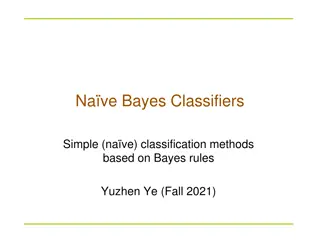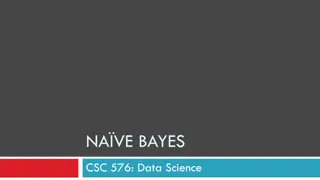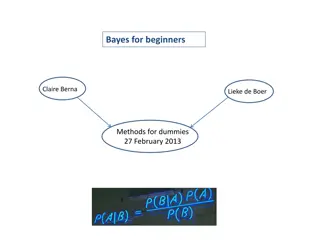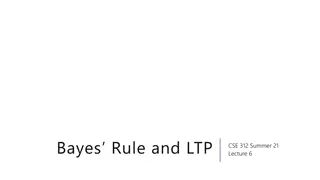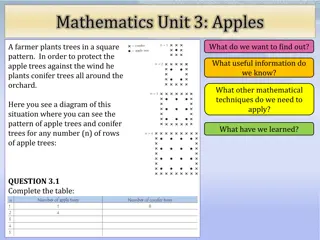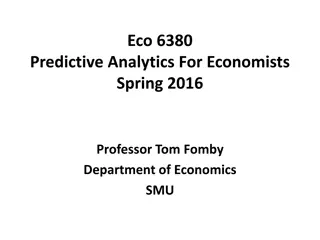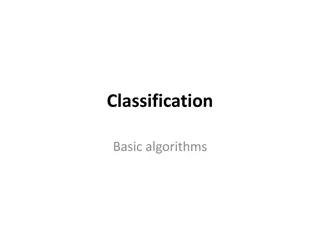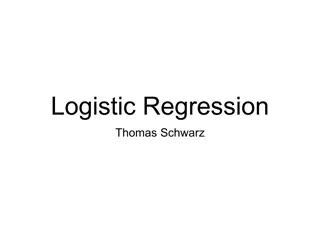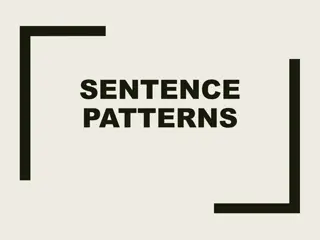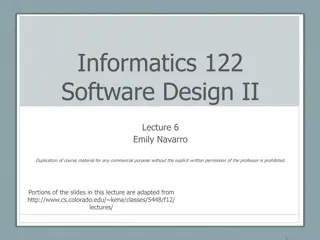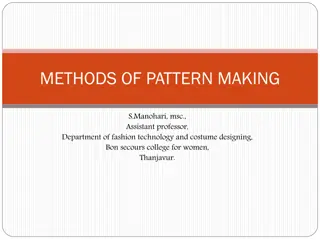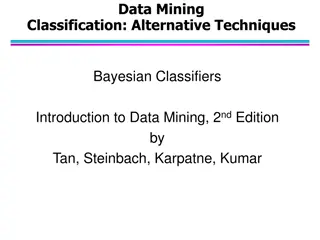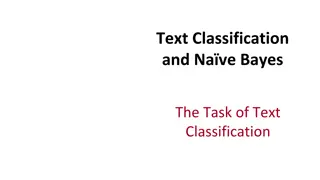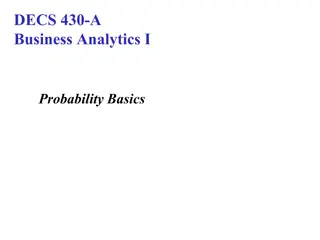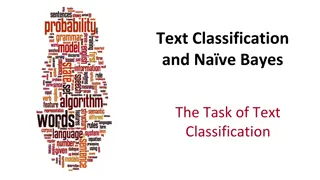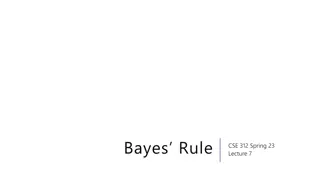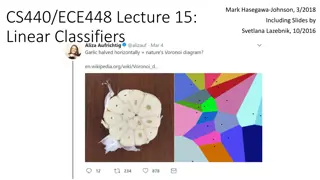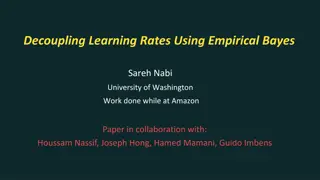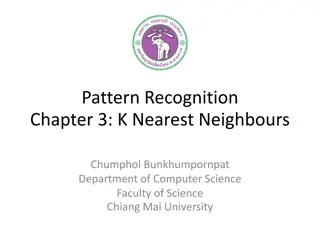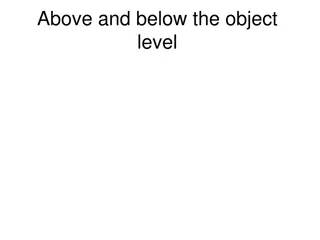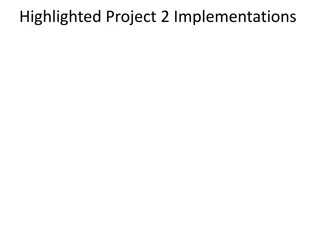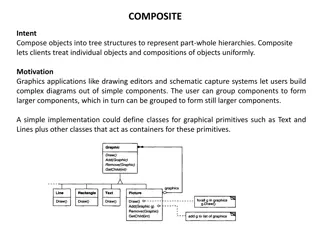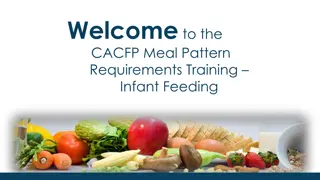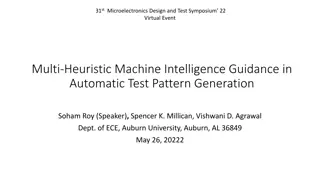Understanding Bayes Classifier in Pattern Recognition
Bayes Classifier is a simple probabilistic classifier that minimizes error probability by utilizing prior and posterior probabilities. It assigns class labels based on maximum posterior probability, making it an optimal tool for classification tasks. This chapter covers the Bayes Theorem, classification examples, and the application of Bayesian belief networks in pattern recognition.
Uploaded on Sep 26, 2024 | 0 Views
Download Presentation

Please find below an Image/Link to download the presentation.
The content on the website is provided AS IS for your information and personal use only. It may not be sold, licensed, or shared on other websites without obtaining consent from the author. Download presentation by click this link. If you encounter any issues during the download, it is possible that the publisher has removed the file from their server.
E N D
Presentation Transcript
Pattern Recognition Chapter 4: Bayes Classifier Chumphol Bunkhumpornpat Department of Computer Science Faculty of Science Chiang Mai University
Learning Objectives Be able to state the Bayes theorem Be able to classify objects using naive Bayes classifiers Be able to understand how Bayesian belief network 2 204453: Pattern Recognition
Bayes Classifier Simple Probabilistic Classifier Optimal Classifier It minimises the average probability of error. Assumption Information about classes is in the form of prior probabilities. Distributions of patterns in the class are known. 3 204453: Pattern Recognition
Bayes Classifier (cont.) It employs the posterior probabilities to assign the class label to a test pattern. A pattern is assigned the label of the class that has the maximum posterior probability. Bayes theorem converts the prior probability into posterior probability based on the pattern to be classified. 4 204453: Pattern Recognition
Bayes Theorem X: Pattern whose class label is unknown Hi: Hypothesis that X belongs to class Ci P(Hi): Prior probability of Hi Known Obtained before observing X P(Hi|X): Posterior probability of Hi conditioned on X P(Hi|X) = P(X|Hi) P(Hi) / P(X) 5 204453: Pattern Recognition
Example 1 In a coffee shop, 99% of the customers prefer coffee. The remaining 1% prefer tea. P(coffee drinker) = 0.99 P(tea drinker) = 0.01 6 204453: Pattern Recognition
Example 1 (cont.) In the absence of any other information, we can classify any customer as a coffee drinker and the probability of error is only 0.01. This is because we are classifying a tea drinker also as a coffee drinker. 7 204453: Pattern Recognition
Example 2 The prior probability of H that a road is wet is P(H) = 0.3. The probability that a road is not wet is 0.7. If we use only this information, then it is good to decide that a road is not wet. The corresponding probability of error is 0.3. 8 204453: Pattern Recognition
Example 2 (cont.) Probability of rain, P(X), is 0.3. If it rains, we need to calculate the posterior probability that the roads are wet, i.e., P(H|X). If 90% of the time when the roads are wet, it is because it has rained. P(X|H) P(it has rained | roads are wet) P(road is wet|it has rained) = P(X|H) P(H) / P(X) = 0.9 0.3 / 0.3 = 0.9 9 204453: Pattern Recognition
Example 2 (cont.) The probability of error is 0.1, which is the probability that a road is not wet given that it has rained. Requirements P(H) P(X|H) P(X) 10 204453: Pattern Recognition
Classification Using Naive Bayes Classifier Class-Conditionally Independent It simplifies the computation (naive). Comparable Performance Classification Trees Neural Network Large Databases High Accuracy High Speed 11 204453: Pattern Recognition
Parameter Estimation Class Priors and Feature Probability Distributions Frequently-Based Probability Estimate It incorporates a small-sample correction . No probability is ever set to be zero. To avoid this, a small value is taken. 12 204453: Pattern Recognition
Example 3 Total number of examples = 100 Number of examples of class 1 = 40 Number of examples of class 2 = 30 Number of examples of class 3 = 30 Prior probability of class 1 = 40/100 = 0.4 Prior probability of class 2 = 30/100 = 0.3 Prior probability of class 3 = 30/100 = 0.3 13 204453: Pattern Recognition
Example 3 (cont.) Out of the 40 examples of Class 1, if a binary feature takes 0 in 30 examples and 1 in 10 examples, then the prior probability that this feature is 0 in this class will be 30/40 = 0.75. 14 204453: Pattern Recognition
Constructing a Classifier from the Probability Model Bayes Probability Model and MAP Decision Rule Most Probable Hypothesis Maximum Posterior Function classify C: Class Variable f1, , fn: n Feature Variables 15 204453: Pattern Recognition
Example Training Data Set 16 204453: Pattern Recognition
Cook = Sita; Mood = Bad; Cuisine = Continental P(Cook = Sita|Tasty = yes) = 2/6 = 0.33 P(Cook = Sita|Tasty = no) = 0/4 = 0 0.01 P(Mood = Bad|Tasty = yes) = 2/6 = 0.33 P(Mood = Bad|Tasty = no) = 3/4 = 0.75 P(Cuisine = Continental|Tasty = yes) = 2/6 = 0.33 P(Cuisine = Continental|Tasty = no) = 3/4 = 0.75 17 204453: Pattern Recognition
Cook = Sita; Mood = Bad; Cuisine = Continental (cont.) P(Tasty = yes|X) = 0.6 0.33 0.33 0.33 = 0.0216 P(Tasty = no|X) = 0.4 0.01 0.75 0.75 = 0.00225 P(Tasty = yes|X) > P(Tasty = no|X) X is classified as belonging to the class Tasty = yes. 18 204453: Pattern Recognition
Bayesian Belief Network Probabilistic Graphical Model (Directed Acyclic Graph) Sets of Variables (Nodes) Probabilistic Dependencies (Arcs) Node A is a parent of Node B if there is an arc from A to B. Parent(Xi): Set of parent nodes of a node Xi 19 204453: Pattern Recognition
Example 4 Ram is a student. He loves going to the movies. He will go to the theatre in the evening if he has money in his pocket. On the other hand, if it rains, he will not go the theatre. When Ram does not go to the movies, he stays home and watches the television. He also dedicates some time to his studies. 20 204453: Pattern Recognition
The variables involved are M: Money in Ram s Pocket R: Rain S: Ram Studies T: Ram watches television. G: Ram goes to the movies. M and R are not influenced by any factor. S and T are influenced by G. 21 204453: Pattern Recognition
Belief Network of How Ram Spends an Evening 22 204453: Pattern Recognition
Example 4 (cont.) Let A stand for negation of the preposition A. The probability that it does not rain, Ram does not have money, Ram goes to the movies and Ram does not watch television P( R, M, G, T) P( R) P( M) P(G| R and M) P( T|G) 0.7 0.4 0.1 1.0 = 0.028 23 204453: Pattern Recognition
Reference Murty, M. N., Devi, V. S.: Pattern Recognition: An Algorithmic Approach (Undergraduate Topics in Computer Science). Springer (2012) 24 204453: Pattern Recognition


